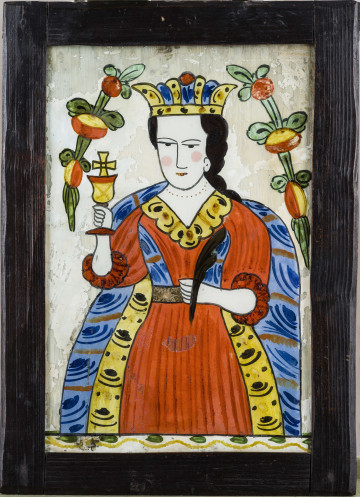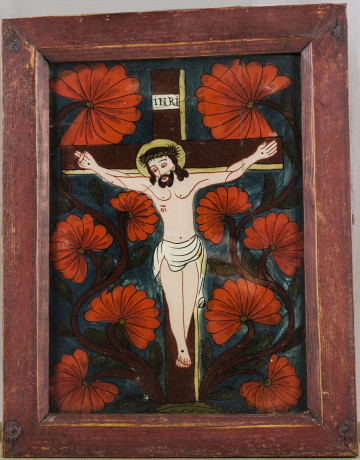
Saint Barbara
1801 — 1900
National Museum in Lublin
Part of the collection: Folk Art of the Lublin Region (17th–1st half of the 20th c.)
Lower Silesia is considered to the cradle of glass painting in Poland, where numerous painting studios were located near glassworks in the Kłodzko Basin and in the Jelenia Góra area. Paintings created there did not form a homogeneous group. They often adopted stylistic features from Podhale, the Czech Republic or Slovakia. Silesian painting was also strongly dependent on official art, it evolved towards greater decorativeness and broader iconography. The preserved small paintings are characterized by: delicate drawing line in red or brown sepia colour, parts of the body marked with delicate shading in grey or grey-olive tonality, fanciful floral decorations (stylized carnations or roses) and names of the saints calligraphed on the dark background under the images.
Most common in Silesia was the image of St Barbara, the main patron saint of miners. Infant Jesus, Christ Crucified, Holy Sepulchre, Ecce Homo, St Anthony, St Francis, St Joseph or St John of Nepomuk, as well as various images of the Virgin Mary, especially from the Jasna Gora painting, and unheard of anywhere else: Our Lady of Bard Śląski and Our Lady of Wambierzyce, venerated in local pilgrimage shrines, were also often depicted. All these figures were depicted in busts, slightly prolonged towards the bottom, filling the whole space, leaving a background for floral ornaments at the top.
This is also how St Apollonia, known in Christianity as the patron saint of tooth and gum disease, was portrayed. The life, or rather death, of the saint is described, among other things, in the letters of St Dionysius the Great about the pogrom of Christians in Alexandria. In late 248 or early 249, Christians there were attacked by followers of other religions - they were dragged out of their homes, robbed of their possessions and brutally murdered. One of these people was a deaconess (nun) who took care of the sick and children. Apolonia was then an elderly person. Despite this, they tried to force her to renounce her faith under torture - her jaws were broken and her teeth extracted. Then she was dragged out of town, where a pyre was burning. There she was faced with a choice: renounce her faith or be thrown into the fire alive. She asked for a moment's reflection and then threw herself into the flames.
Author / creator
Dimensions
cały obiekt: height: 28 cm, width: 39,5 cm
Object type
picture
Technique
painting technique
Material
glass, oil-based paint
Creation time / dating
Creation / finding place
Owner
The National Museum in Lublin
Identification number
Location / status

1801 — 1900
National Museum in Lublin

1801 — 1900
National Museum in Lublin

1801 — 1900
National Museum in Lublin
DISCOVER this TOPIC
National Museum in Szczecin
DISCOVER this PATH
Educational path